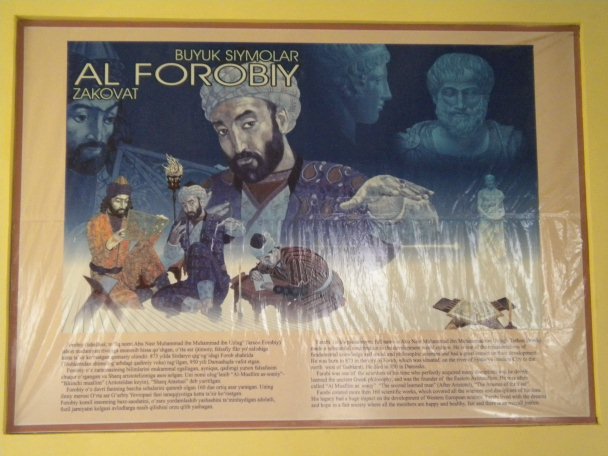
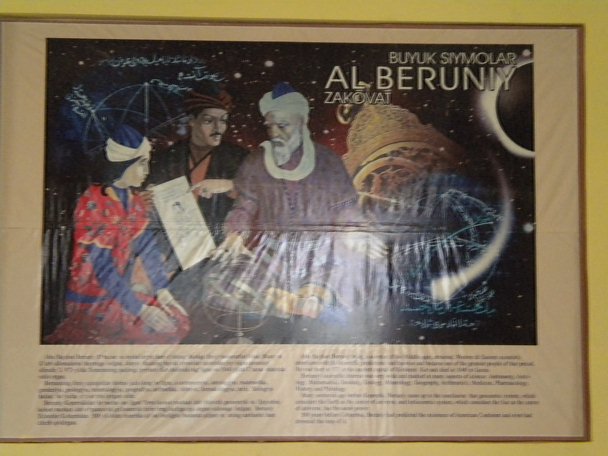
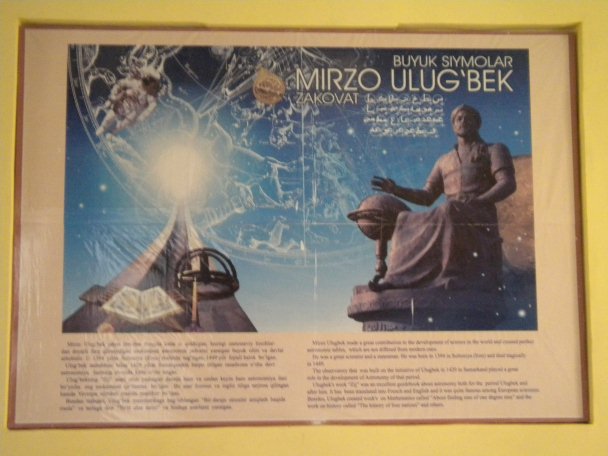



![]() Unmittelbar im Treppenhaus, wenn man das zweite Obergeschoss erreicht, wo die Fakultät
für Mathematik angesiedelt ist, wird man von drei Plakaten überrascht. Sie
informieren über
Abu Nasr Muhammad al-Farabi,
Abu
Arrayhan Muhammad ibn Ahmad al-Biruni und
Mirza
Ulug Bek. Die Beschreibungen sind zweisprachig gestaltet, Grundlage für die
nachstehenden Übersetzungen sind die jeweils englischen Varianten:
Unmittelbar im Treppenhaus, wenn man das zweite Obergeschoss erreicht, wo die Fakultät
für Mathematik angesiedelt ist, wird man von drei Plakaten überrascht. Sie
informieren über
Abu Nasr Muhammad al-Farabi,
Abu
Arrayhan Muhammad ibn Ahmad al-Biruni und
Mirza
Ulug Bek. Die Beschreibungen sind zweisprachig gestaltet, Grundlage für die
nachstehenden Übersetzungen sind die jeweils englischen Varianten:
| Zu Abu Nasr al-Farabi, wobei betont werden muss, dass auf dem
Plakat auch das Konterfei von
Aristoteles1)
wiedergegeben ist, dessen Bedeutung sich weiter unten im Text ergibt: Farabi (ist sein Pseudonym; sein vollständiger Name lautet Abu Nasr Muhammad ibn Muhammad ibn Uzlugh Tarhon Farabi) leistete einen wesentlichen Beitrag für die Entwicklung der Weltkultur. Er ist einer der Vertreter von grundlegendem Wissen und der sozialen und philosophischen Wissenschaften und hat großen Einfluss auf deren Entwicklung. Er wurde 873 in der Stadt Farab geboren, welche am Fluss Syrdarya liegt und eine antike Stadt nordwestlich von Taschkent ist. Er verstarb 950 in Damaskus2). Farabi war einer der Wissenschaftler seiner Zeit, welche vollkommen viele Fachgebiete vertraten. Er studierte tiefgehend die griechische Philosophie des Altertums und war einer der Begründer des östlichen Aristotelismus. Oft wurde er "Al Muallim as soniy" - "Zweiter Gelehrter" (nach Aristoteles) - genannt, "Der Arastus des Ostens". Farabi verfasste mehr als 160 wissenschaftliche Werke, welche alle Wissenschaften und Disziplinen seiner Zeit berühren. Sein Vermächtnis hat einen großen Einfluss auf die Entwicklung westeuropäischer Wissenschaften. Farabi lebte in seinen Träumen und Hoffnungen in einer aufrichtigen Gesellschaft, in der all ihre Mitglieder froh, gesund, unbescholten sind und es eine globale Gerechtigkeit gibt. |
| Zu Abu Arrayhan al-Biruni: Abu Rayhon Beruniy3) erhielt als Wissenschaftler des Mittelalters mit seinen Vorhersagen und Theorien die Aufmerksamkeit westlicher wie östlicher Wissenschaftler. Er wurde einer der bedeutendsten Persönlichkeiten dieser Aera. Er wurde 973 in der antiken Hauptstadt Choresmiens Kot geboren und verstarb 1048 in Gazna. Beruniys wissenschaftliches Interesse war sehr vielfältig und prägte viele wissenschaftliche Aspekte: Astronomie, Astrologie, Mathematik, Geodäsie, Geologie, Mineralogie, Geographie, Arithmetik, Medizin, Pharmakologie, Geschichte und Philologie. Viele Jahrhunderte vor Kopernikus, kam Beruniy bereits zu dem Schluss, dass das geozentrische System, bei dem die Erde im Mittelpunkt des Universums steht, und das heliozentrische System, bei dem der Sonne diese Position zukommt, gleichwertig sind. 500 Jahre vor Columbus hat Beruniy die Existenz eines amerikanischen Kontinents vorhergesagt und eine Karte von ihm gezeichnet(?)4). |
| Zu Mirza Ulug Bek: Mirza Ulugbek lieferte große Beiträge zur weltweiten Entwicklung der Wissenschaften und erstellte genaue astronomische Tabellen, welche sich von modernen nicht unterscheiden5). Er war ein großer Wissenschaftler und Staatsmann. Er wurde 1394 in Sultoniya (Iran) geboren und verstarb in tragischer Weise im Jahr 1449. Das Observatorium, das auf Initiative von Ulug Bek 1429 in Samarkand erbaut wurde, spielte eine große Rolle bei der Weiterentwicklung der Astronomie zu dieser Zeit. Ulugbeks Werk Zij war eine herausragende Anleitung über Astronomie zur seiner Zeit und auch danach. Es wurde in die französische und englische Sprache übersetzt und war recht berühmt unter europäischen Wissenschaftlern. Davon abgesehen verfasste Ulugbek die Ausarbeitung zur Mathematik "Über das Berechnen des Sinus aus dem Sinus von einem Grad(?)" und das Werk zur Geschichte - genannt "Die Geschichte von vier Nationen" - sowie weitere. |
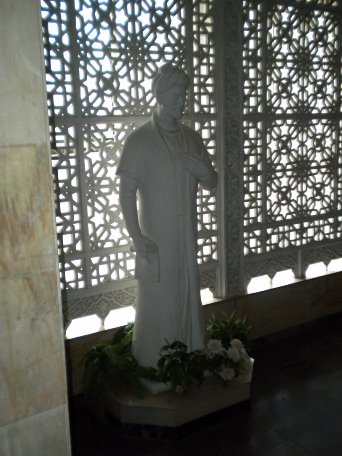 Es sei noch darauf hingewiesen, dass auf der rechten Seite des
Plakats zu Mirza Ulug Bek nicht das Denkmal in Samarkand, sondern
jenes in Taschkent wiedergegeben ist.
Es sei noch darauf hingewiesen, dass auf der rechten Seite des
Plakats zu Mirza Ulug Bek nicht das Denkmal in Samarkand, sondern
jenes in Taschkent wiedergegeben ist.
Im Eingangsbereich zu diesem Gebäude finden sich zwei Wandgemälde zu denen es aber keine Hinweise gibt, wen und was sie darstellen. Sie sind beide am Ende dieser Seite wiedergegeben. Bei dem oberen der beiden Gemälde allerdings finden sich Indizien, die auf Mirza Ulug Bek hinweisen, so zum Beispiel eine Figur, die den Doppelquadranten darstellen könnte. Weiterhin lässt sich auch ein Modell des Teilkreises des Observatoriums erkennen.
Auf dem Treppenabsatz zwischen Erd- und dem ersten Obergeschoss ist die nebenstehende Statue aufgestellt, die auch wieder Mirza Ulug Bek darstellen könnte. Wie gesagt kann dies aber nur vermutet werden.
Im zweiten Obergeschoss sind nicht nur die oben gezeigten Plakate zu finden, sondern auch noch eine ganze Reihe von Porträts namhafter Mathematiker. Diese sind einzig aus dem Grund, die Komplexität der vorliegenden Beschreibung überschaubar zu halten separat gezeigt und beschrieben (siehe Galerie der Mathematiker in Samarkand).
Die Fotos wurden im Oktober 2011 aufgenommen.
1) Rechts oben auf dem Plakat ist Aristoteles porträtiert. Unmittelbar darunter ist eine Statue abgebildet. Auch wenn diese an das Denkmal in Stagira erinnert, so muss man doch feststellen, dass es Unterschiede gibt. (Zurück zum Bezug)
2) Andere Quellen (zum Beispiel [1]) benennen Aleppo als Sterbeort. (Zurück zum Bezug)
3) In den Texten wird die im Original verwendete Schreibweise beibehalten, bei A. A. Al-Biruni und Mirza Ulug Bek ist es hier die usbekische. (Zurück zum Bezug)
4) Der Wortlaut bezüglich der Leistungen der auf den Plakaten gewürdigten Persönlichkeiten sind recht vollmundig ausgefallen. (Zurück zum Bezug)
5) Die Genauigkeit der Tabellen Mirza Ulug Beks ist für die damalige Zeit unbestritten. Auf welche Merkmale sich die Feststellung bezieht, bleibt das Geheimnis des Autors (vom Plakat). (Zurück zum Bezug)
![]() When ascending the staircase to the second floor where the faculty of mathematics is located
one cannot overlook three large posters. They inform on
Abu Nasr Muhammad al-Farabi,
Abu
Arrayhan Muhammad ibn Ahmad al-Biruni und
Mirza
Ulug Bek (from left to right). The explaining texts are provided in Usbek and English.
The latters are provided in the following:
When ascending the staircase to the second floor where the faculty of mathematics is located
one cannot overlook three large posters. They inform on
Abu Nasr Muhammad al-Farabi,
Abu
Arrayhan Muhammad ibn Ahmad al-Biruni und
Mirza
Ulug Bek (from left to right). The explaining texts are provided in Usbek and English.
The latters are provided in the following:
| With respect to Abu Nasr al-Farabi where one should mention that
this poster also shows a portrait of
Aristotle1) becoming clear by
reading the following text: Farabi (is his pseudonym; full name is Abu Nasr Muhammad ibn Muhammad ibn Uzlugh Tarhon Farabi) made a substantial contribution to the development world culture. He is one of the representatives of fundamental knowledge and social and philosophic sciences and had a great impact on their development. He was born in 873 in the city of Forob, which is situated on the river of Syrdarya (ancient city to the north west of Taschkent). He died 950 in Damasks2). Farabi was one of the scientists of his time who perfectly acquired many disciplines and he deeply learned the ancient Greek philosophy, and was the founder of the Eastern Aristotelism. He was often called "Al Muallim as soniy""The second learned man" (after Aristotle), "The Arastus of the East". Farabi created more than 160 scientific works, which covered all the sciences and disciplines of his time. His legacy had a huge impact on the development of western European science. Farabi lived with the dreams and hope in a fair society where all the members are happy and healthy, fair and there is an overall justice. |
| With respect to Abu Arrayhan al-Biruni: Abu Rayhon Beruniy3) being a scientist of the Middle ages, attracted Western & Eastern scientist's attention with his scientific predictions and theories and became one of the greatest people of that period. He was born in 973 in the ancient capital of Krohezm Kot and died 1048 in Gazna. Beruniy's scientific interest was very wide and marked at many aspects of science: Astronomy, astrology, mathematics, geodesy, geology, mineralogy, geography, arithmetics, medicine, pharmacology, history, and philology. Many centuries ago before Kopernik, Beruniy came up to the conclusion that geocentric system, which considers the Earth as the center of universe, and heliocentric system, which considers the Sun as the centre of universe, has the same power. 500 years before Columbus, Beruniy had predicted the existence of American continent and even had drowned the map of it(?)4). |
| With respect to Mirza Ulug Bek: Mirza Ulugbek made a great contribution to the development of science in the world and created perfect astronomic tables, which are not differed from modern ones5). He was a great scientist and a statesman. He was born in 1394 in Sultoniya (Iran) and died tragically in 1449. The observatory that was built on the initiative of Ulugbek in 1429 in Samarkand played a great role in the development of astronomy of that period. Ulugbek's work "Zij" was an excellent guidebook about astronomy both for the period Ulugbek and after him. It has been translated into French and English and it was quite famous among European scientists. Besides, Ulugbek created works on mathematics called "About finding sine of one degree sine" and the work on history called "The history of four nations" and others. |
It should be mentioned that the poster concerning Ulugh Bek doesn't show the monument in Samarkand but the one in Taschkent.
Moreover the entrance lounge of the building possesses there are two wall-paintings but without any hint who and what they present. The first one which is provided below unveils several objects related to Ulugh Beg, e. g. the double quadrant and a model of the observatory.
Moreover on the intermediate platform of the staircase between ground floor and first floor a statue is erected. One may guess that it present Ulugh Beg as well (see the photograph above on the right).
In the second floor not only the posters are provided but also a lot of portraits of wellknown mathematicians may be found. For the sake of reducing complexity they are provided on another page called Gallery of mathematicians in Samarkand.
The photographs were taken in October 2011.
1) In the upper right corner of the poster a portrait of Aristotle is shown. Below of it a statue is presented which looks like the one in Stagira. But there are some differences which avoid this relation. (Back to the reference)
2) Other sources (e. g. [1] mention that he died in Aleppo. (Back to the reference)
3) The original spelling of the names is used in these texts. Here the names of A. A. Al-Biruni and M. Ulugh Beg it is the Usbek one. (Back to the reference)
4) The achievements of the personages is described in a rather full-bodied manner. (Back to the reference)
5) The precision of the tables of M. Ulugh Beg is certainly accepted when taking into account the circumstances. But how this comparison is meant remains the secret of the author of the poster. (Back to the reference)
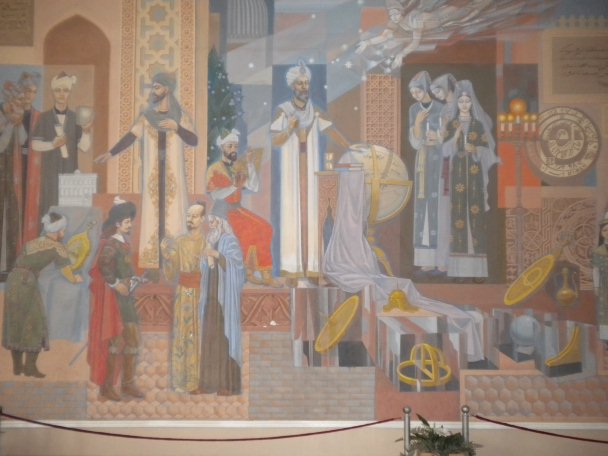
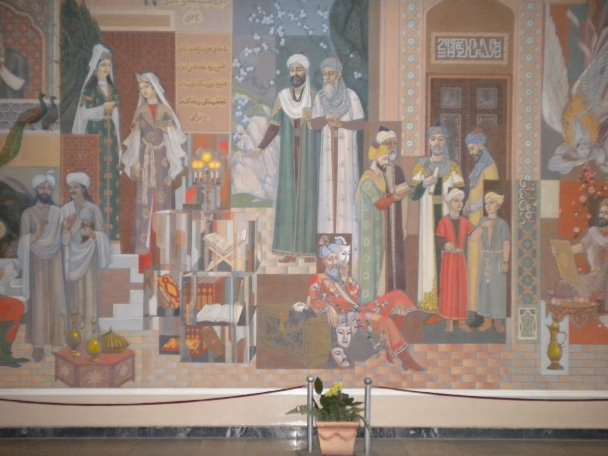
| [1] | Gottwald, Siegfried, Ilgauds, Hans-Joachim and Schlote, Karl-Heinz (Eds.): Lexikon bedeutender Mathematiker, 1. ed., Verlag Harri Deutsch, Thun - Frankfurt am Main, 1990, ISBN 3-8171-1164-9 |
| Back to the main page | Created by Wolfgang Volk in November 2011 |